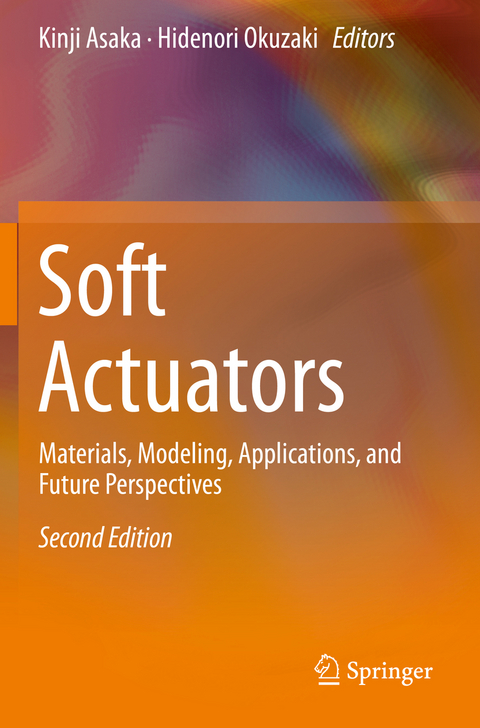
Soft Actuators
Springer Verlag, Singapore
978-981-13-6852-3 (ISBN)
Kinji Asaka received his Ph.D. degree in Science from Kyoto University in 1990. He is currently a Group Leader of Hybrid Actuator Group, Inorganic Functional Material Research Institute at AIST. His current research interests include interfacial electrochemistry and polymer actuators. He is a member of the Society of Polymer Science, Japan and the Society of Instrument and Control Engineers. Hidenori Okuzaki received his Ph.D. degree in Science from Hokkaido University in 1994. Since 1994, he has been working on organic electronics using conductive polymers as an assistant professor of the Faculty of Engineering, University of Yamanashi. He has been an associate professor in 2003 and he has dealt with conducting micro- and nano-fibers, and organic field-effect transistors. Since 2014, he has been a professor of the Graduate Faculty of Interdisciplinary Research, University of Yamanashi and he has been focusing on the synthesis of highly conductive polymers andapplications to soft sensors and actuators for organic robotics.
Progress and Current Status of Materials and Properties of Soft Actuators.- Current Status of Applications and Markets of Soft Actuators.- Electromagnetic Heating.- Thermo-Responsive Nanofiber Mats Fabricated by Electrospinning.- Evolution of Self-Oscillating Polymer Gels as Autonomous Soft Actuators.- Polyrotaxane Actuators.- Ionic Conductive Polymers.- Conducting Polymers.- Humidity-Sensitive Conducting Polymer Actuators.- Carbon Nanotube/Ionic Liquid Composites.- Ion Gels for Ionic Polymer Actuators.- Ionic Liquid/Polyurethane/PEDOT:PSS Composite Actuators.- Dielectric Gels.- Dielectric Elastomers.- Piezoelectric Polymers.- Thermal and Electrical Actuation of Liquid Crystal Elastomers/Gels.- Spiropyran-Functionalized Hydrogels.- Photomechanical Energy Conversion with Cross-Linked Liquid-Crystalline Polymers.- Photoredox Reaction.- Magnetic Fluid Composite Gels.- Magnetic Particle Composite Gels.- Molecular Mechanism of Electrically Induced Volume Change of Porous Electrodes.- Computational Modeling of Mechanical Sensors Using Ionic Electro-Active Polymers.- Distributed Parameter System Modeling.- Control of Electro-Active Polymer Actuators with Considering Characteristics Changes.- Motion Design-A Gel Robot Approach.- Motion Control.- IPMC Actuation Mechanisms and Multi-Physical Modeling.- Sensing Properties and Physical Model of Ionic Polymer.- Modelling of Dielectric Elastomer Actuator.- Modelling of Dielectric Gel using Multi-Physics Coupling Theory.- Modeling and Control of Fishing-Line/Sewing-Thread Artificial Muscles (Twisted and Coiled Polymer Fibers, TCPFs).- Underwater Soft Robots.- IPMC Actuator-Based Multifunctional Underwater Microrobots.- Medical Applications.- Elastomer Transducers.- Dielectric Elastomer Sensors: Development of Stretchable Strain Sensor System.- Tissue Engineering Approach to Making Soft Actuators.- Integration of Soft Actuators based on a Biomolecular Motor System to Develop Artificial Machines.- Employing Cytoskeletal Treadmilling in Bio-Actuators.
| Erscheinungsdatum | 12.09.2020 |
|---|---|
| Zusatzinfo | 275 Illustrations, color; 220 Illustrations, black and white; X, 740 p. 495 illus., 275 illus. in color. |
| Verlagsort | Singapore |
| Sprache | englisch |
| Maße | 155 x 235 mm |
| Themenwelt | Informatik ► Theorie / Studium ► Künstliche Intelligenz / Robotik |
| Naturwissenschaften ► Chemie ► Organische Chemie | |
| Technik ► Elektrotechnik / Energietechnik | |
| Technik ► Maschinenbau | |
| Schlagworte | Artificial Muscle • Conductive Polymer • Dielectric Elastomer • Ionic Polymer • Soft Actuator |
| ISBN-10 | 981-13-6852-X / 981136852X |
| ISBN-13 | 978-981-13-6852-3 / 9789811368523 |
| Zustand | Neuware |
| Informationen gemäß Produktsicherheitsverordnung (GPSR) | |
| Haben Sie eine Frage zum Produkt? |
aus dem Bereich


